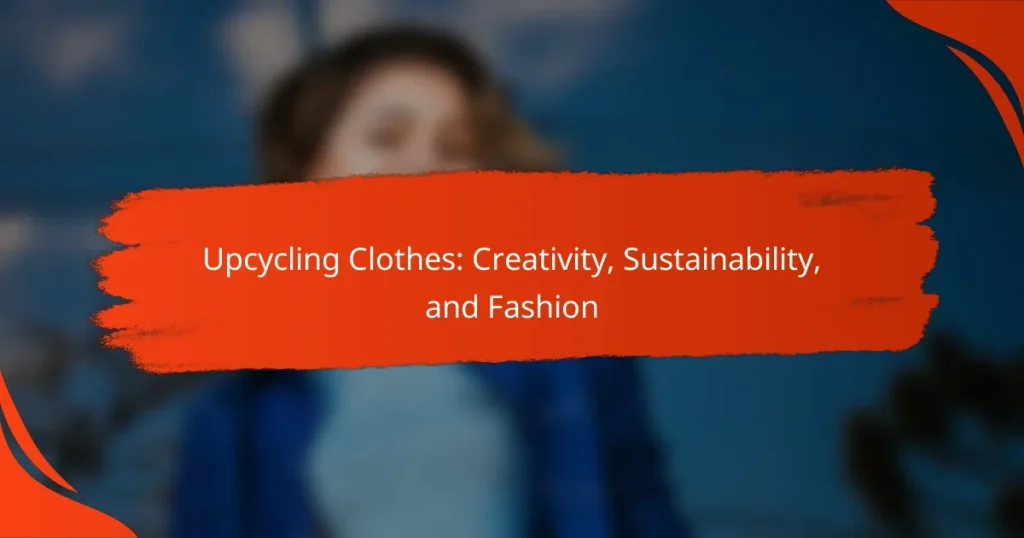Sustainable fashion is an approach that emphasizes minimizing environmental impact and promoting ethical labor practices within the clothing industry. By prioritizing responsible sourcing, eco-friendly materials, and transparency in supply chains, it aims to create a more responsible and ethical fashion landscape. Consumers play a crucial role in this movement by supporting brands that demonstrate a commitment to sustainability and ethical practices.
Capsule Wardrobe: Eco-Friendly Pieces, Versatility, and Style
Ethical Fashion Influencers: Inspiration, Trends, and Advocacy
Upcycling Clothes: Creativity, Sustainability, and Fashion
Budget-Friendly Sustainable Fashion: Options, Styles, and Savings
Eco-Friendly Fabrics: Types, Benefits, and Uses
Sustainable Footwear Brands: Comfort, Style, and Eco-Consciousness
What are the best practices for sustainable fashion in the UK?
The best practices for sustainable fashion in the UK focus on minimizing environmental impact while promoting ethical labor practices. Key strategies include sourcing materials responsibly, using eco-friendly dyes, supporting local artisans, ensuring transparency in supply chains, and implementing recycling and upcycling initiatives.
Ethical sourcing of materials
Ethical sourcing involves selecting materials that are produced with respect for the environment and fair labor practices. This can include organic cotton, Tencel, and recycled fabrics. Brands should aim to work with suppliers who adhere to recognized standards, such as the Global Organic Textile Standard (GOTS).
When choosing materials, consider the environmental footprint, including water usage and chemical treatments. Opting for local materials can also reduce transportation emissions, making the supply chain more sustainable.
Use of eco-friendly dyes
Eco-friendly dyes are crucial for reducing pollution in the fashion industry. Traditional dyes can contain harmful chemicals that damage waterways and ecosystems. Brands should prioritize natural dyes or low-impact synthetic dyes that meet environmental safety standards.
When selecting dyes, look for certifications like OEKO-TEX or GOTS, which ensure that the dyes used are safe for both the environment and human health. This practice not only benefits the planet but also appeals to increasingly eco-conscious consumers.
Support for local artisans
Supporting local artisans fosters community development and preserves traditional craftsmanship. By sourcing products from local makers, brands can help sustain local economies and reduce carbon footprints associated with long-distance shipping.
Consider collaborating with local artisans for unique, limited-edition collections. This not only enhances brand storytelling but also creates a direct connection between consumers and the artisans who create their garments.
Transparency in supply chains
Transparency in supply chains is essential for building consumer trust and accountability. Brands should disclose information about where and how their products are made, including labor conditions and environmental practices.
Utilizing tools like supply chain mapping can help brands identify areas for improvement and communicate their sustainability efforts effectively. Consumers increasingly demand transparency, making it a competitive advantage in the market.
Recycling and upcycling initiatives
Recycling and upcycling initiatives help reduce textile waste and promote a circular economy. Brands can implement take-back programs, encouraging customers to return old garments for recycling or repurposing.
Consider partnering with organizations that specialize in textile recycling or creating new products from old materials. This not only minimizes waste but also inspires creativity and innovation within the brand.
How can I identify sustainable fashion brands?
Identifying sustainable fashion brands involves looking for specific indicators that demonstrate their commitment to ethical practices and environmental responsibility. Key factors include certification labels, brand transparency, and customer feedback.
Certification labels like GOTS and Fair Trade
Certification labels are essential for verifying a brand’s sustainability claims. The Global Organic Textile Standard (GOTS) ensures that textiles are made from organic fibers and meet strict environmental and social criteria. Fair Trade certification focuses on fair wages and safe working conditions for producers.
When shopping, look for these labels on clothing tags or product descriptions. Brands that are certified often display these logos prominently, making it easier for consumers to make informed choices.
Brand transparency and mission statements
Brand transparency refers to how openly a company shares information about its supply chain, production processes, and sustainability efforts. A clear mission statement that emphasizes ethical practices can indicate a genuine commitment to sustainability.
Research a brand’s website for details on their sourcing, labor practices, and environmental impact. Brands that provide comprehensive information are often more trustworthy in their sustainability claims.
Customer reviews and ratings
Customer reviews can provide insights into a brand’s sustainability practices and product quality. Look for feedback that specifically mentions the brand’s ethical practices, durability of products, and overall satisfaction.
Online platforms and social media can be valuable resources for gauging customer sentiment. Pay attention to patterns in reviews, as consistent praise or criticism can help you assess a brand’s reliability in sustainable fashion.
What are the benefits of sustainable fashion?
Sustainable fashion offers numerous advantages, including a reduced environmental footprint and support for ethical labor practices. By prioritizing eco-friendly materials and fair labor conditions, consumers can contribute to a more responsible fashion industry.
Reduced environmental impact
Sustainable fashion significantly lowers the environmental impact of clothing production. This includes using organic materials, minimizing water consumption, and reducing waste through recycling and upcycling practices. For example, brands that utilize organic cotton or recycled polyester can help decrease the pollution associated with conventional textile manufacturing.
Choosing sustainable fashion can also lessen carbon emissions. Many eco-conscious brands focus on local production to reduce transportation-related emissions, which can be a substantial part of a garment’s carbon footprint.
Support for ethical labor practices
One of the key benefits of sustainable fashion is its commitment to ethical labor practices. This means ensuring fair wages, safe working conditions, and respect for workers’ rights throughout the supply chain. Brands that adhere to these principles often undergo third-party certifications, such as Fair Trade or GOTS (Global Organic Textile Standard).
By supporting companies that prioritize ethical labor, consumers can help combat exploitation and promote social responsibility in the fashion industry. This not only benefits workers but also fosters a more sustainable and equitable economy.
Long-lasting quality of garments
Sustainable fashion emphasizes the production of high-quality garments designed to last. Unlike fast fashion, which often prioritizes low cost over durability, sustainable brands focus on craftsmanship and timeless designs. This results in clothing that withstands wear and tear, reducing the need for frequent replacements.
Investing in long-lasting pieces can be more economical in the long run. While the initial cost may be higher, the longevity of sustainable garments means fewer purchases over time, ultimately saving money and resources.
How does sustainable fashion impact consumer behavior?
Sustainable fashion significantly influences consumer behavior by encouraging individuals to prioritize eco-friendly choices and ethical practices in their purchasing decisions. This shift often leads to increased demand for brands that demonstrate commitment to sustainability and social responsibility.
Increased awareness of environmental issues
The rise of sustainable fashion has heightened consumer awareness regarding environmental challenges such as pollution, waste, and resource depletion. Shoppers are now more informed about the ecological footprint of their clothing choices, prompting them to seek brands that prioritize sustainable materials and production methods.
For example, many consumers are now opting for organic cotton or recycled fabrics, which have a lower environmental impact compared to conventional materials. This shift not only reflects a change in personal values but also encourages brands to adopt more sustainable practices to meet consumer expectations.
Shift towards minimalism and conscious consumption
Sustainable fashion promotes a minimalist lifestyle, where consumers focus on quality over quantity. This approach encourages individuals to buy fewer, higher-quality items that are versatile and durable, rather than fast fashion pieces that are quickly discarded.
Conscious consumption involves making deliberate choices about what to buy, often leading to practices like thrifting or supporting local artisans. By embracing this mindset, consumers can reduce waste and support sustainable economies, ultimately fostering a more responsible fashion industry.
What are the challenges facing sustainable fashion?
Sustainable fashion faces several significant challenges that hinder its widespread adoption. Key issues include higher production costs, lack of consumer awareness, and greenwashing by brands, all of which complicate the transition to more eco-friendly practices.
Higher production costs
One of the main challenges in sustainable fashion is the higher production costs associated with eco-friendly materials and ethical labor practices. Sustainable fabrics, such as organic cotton or recycled polyester, often cost more to produce than conventional alternatives. This can lead to higher retail prices for consumers, which may deter some from purchasing sustainable options.
Brands may need to balance these costs by offering fewer discounts or creating a more premium product line. Consumers should be prepared to invest in quality items that are made to last, rather than opting for cheaper, fast-fashion alternatives that contribute to environmental degradation.
Lack of consumer awareness
Many consumers are not fully aware of the environmental and social impacts of their clothing choices. This lack of awareness can lead to a preference for fast fashion, as shoppers may prioritize price and style over sustainability. Educating consumers about the benefits of sustainable fashion is crucial for driving demand.
Brands can help bridge this gap by providing transparent information about their sourcing, production processes, and the environmental benefits of their products. Engaging marketing campaigns and collaborations with influencers can also raise awareness and encourage more sustainable purchasing behaviors.
Greenwashing by brands
Greenwashing occurs when brands falsely claim to be environmentally friendly to attract consumers without making significant changes to their practices. This can mislead consumers and undermine genuine sustainable efforts in the fashion industry. Recognizing greenwashing is essential for consumers who want to support truly sustainable brands.
To avoid falling for greenwashing, consumers should look for third-party certifications, such as Fair Trade or Global Organic Textile Standard (GOTS), which indicate a brand’s commitment to sustainability. Researching brands and reading reviews can also help shoppers make informed choices and support companies that prioritize ethical practices.
How can I incorporate sustainable fashion into my wardrobe?
Incorporating sustainable fashion into your wardrobe involves choosing clothing that is environmentally friendly and ethically produced. This can include opting for second-hand items, supporting eco-conscious brands, and being mindful of your purchasing habits.
Thrift shopping and second-hand stores
Thrift shopping and second-hand stores are excellent ways to find unique clothing while reducing waste. These shops often carry a wide variety of styles at lower prices, making it easier to build a sustainable wardrobe without overspending.
When shopping at thrift stores, look for high-quality materials and timeless pieces that can be worn in multiple ways. Check for any signs of wear or damage, and remember that minor repairs can often extend the life of a garment.
To maximize your thrift shopping experience, consider visiting stores in affluent neighborhoods, as they may have a higher turnover of quality items. Additionally, frequent visits can help you discover new arrivals and unique finds that align with your sustainable fashion goals.






